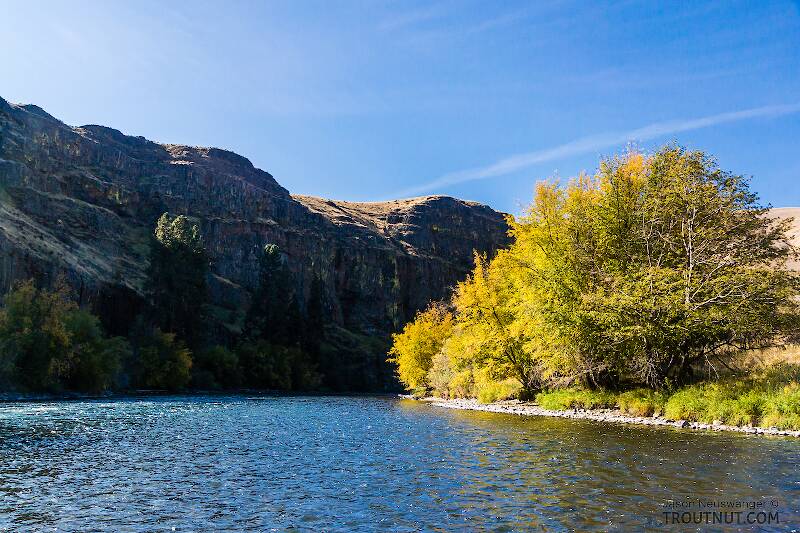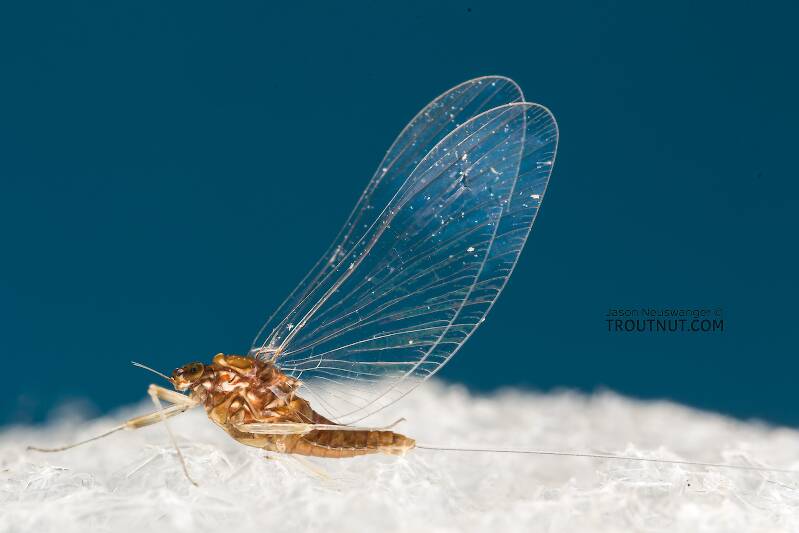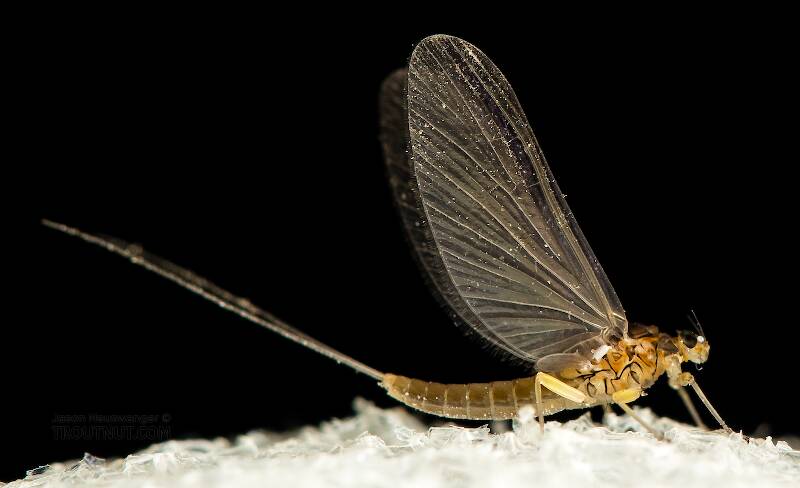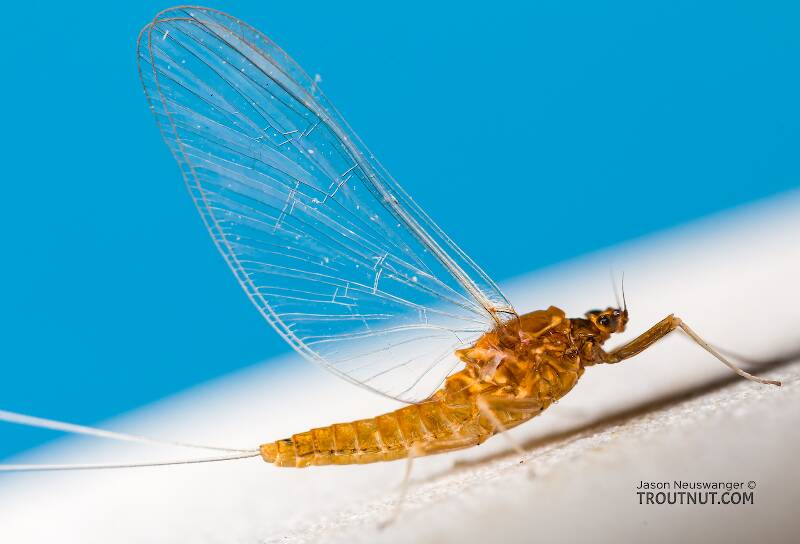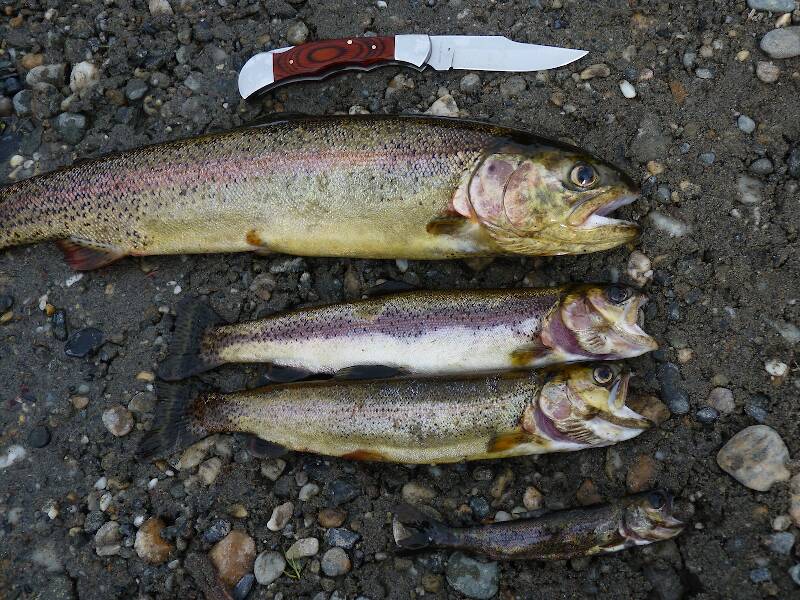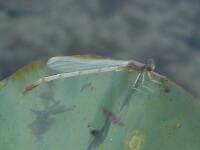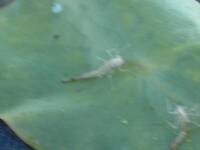
Salmonflies
Pteronarcys californica
The giant Salmonflies of the Western mountains are legendary for their proclivity to elicit consistent dry-fly action and ferocious strikes.
Featured on the forum
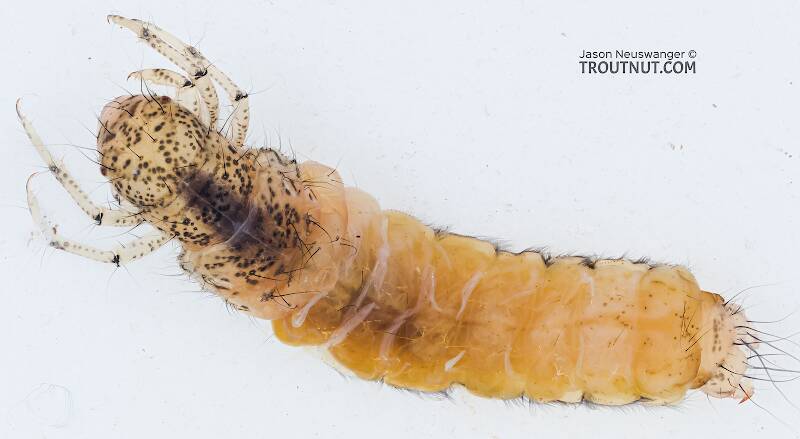
This is a striking caddis larva with an interesting color pattern on the head. Here are some characteristics I was able to see under the microscope, but could not easily expose for a picture:
- The prosternal horn is present.
- The mandible is clearly toothed, not formed into a uniform scraper blade.
- The seems to be only 2 major setae on the ventral edge of the hind femur.
- Chloride epithelia seem to be absent from the dorsal side of any abdominal segments.
Based on these characteristics and the ones more easily visible from the pictures, this seems to be Grammotaulius. The key's description of the case is spot-on: "Case cylindrical, made of longitudinally arranged sedge or similar leaves," as is the description of the markings on the head, "Dorsum of head light brownish yellow with numerous discrete, small, dark spots." The spot pattern on the head is a very good match to figure 19.312 of Merritt R.W., Cummins, K.W., and Berg, M.B. (2019). The species ID is based on Grammotaulius betteni being the only species of this genus known in Washington state.
- The prosternal horn is present.
- The mandible is clearly toothed, not formed into a uniform scraper blade.
- The seems to be only 2 major setae on the ventral edge of the hind femur.
- Chloride epithelia seem to be absent from the dorsal side of any abdominal segments.
Based on these characteristics and the ones more easily visible from the pictures, this seems to be Grammotaulius. The key's description of the case is spot-on: "Case cylindrical, made of longitudinally arranged sedge or similar leaves," as is the description of the markings on the head, "Dorsum of head light brownish yellow with numerous discrete, small, dark spots." The spot pattern on the head is a very good match to figure 19.312 of Merritt R.W., Cummins, K.W., and Berg, M.B. (2019). The species ID is based on Grammotaulius betteni being the only species of this genus known in Washington state.

Troutnut is a project started in 2003 by salmonid ecologist Jason "Troutnut" Neuswanger to help anglers and
fly tyers unabashedly embrace the entomological side of the sport. Learn more about Troutnut or
support the project for an enhanced experience here.
This topic is about the Mayfly Family Baetidae
"These little critters supplant the importance of many other well-known mayfly hatches."
-Fred Arbona in Mayflies, the Angler, and the Trout
Arbona did not overestimate these critters. Their great numbers and multiple broods each season make up for their size, which is rarely larger than size 16 and often smaller than size 20.
Hardly mentioned in angling literature prior to the middle of the last century, baetids have become increasingly important to anglers, rivaling any other family of mayflies in this regard. This is largely due to the extension of fishing seasons that now include the early and late periods when this family’s species usually dominate hatching activity. Another important reason is the tremendous improvement in tackle allowing more practical imitation of these little mayflies. The dramatic ecological changes in many of our watersheds and the subsequent impact this has had on the makeup of taxa populations is also a factor.
Common baetid hatches with a national distribution are the species Acentrella turbida, Baetis brunneicolor, and Baetis tricaudatus. In the West, Baetis bicaudatus, Diphetor hageni and Plauditus punctiventris can also be common. In the East and the Midwest, look for Baetis intercalaris and Plauditus dubius. The species Iswaeon anoka is important in both the West and Midwest. Some of the Procloeon and Anafroptilum (previously Centroptilum) species are coming to the increasing notice of anglers across the country.
Stillwater anglers are likely to run across Callibaetis ferrugineus ferrugineus in the East and Midwest. Western anglers will find Callibaetis californicus and Callibaetis ferrugineus hageni to be very important.
Streamside identification of these mayflies to the level of genus, let alone species, has always been difficult. It's a very rare angler who can correctly proclaim a mayfly to be "Baetis" at a glance and be right on purpose, rather than making a lucky (albeit likely) guess at that genus versus the many others in the family. This is now even more so as new taxonomic evidence has shown hind wing conformation (or lack of hind wings) and other features are less dependable as ways to tell the genera apart. Many of the lesser-known species probably produce excellent local hatches but have not caught enough attention to be properly recognized by anglers. The lesson is that we should not assume anything about the identity of many Baetidae hatches we come across; they may not even be in the Baetis genus, let alone familiar species.
Example specimens
Entoman on Feb 5, 2012February 5th, 2012, 9:22 am EST
Tony -
Not at all, you are absolutely right. In my attractor box, I keep my parachute Adams area well stocked with them, and I also use them on a few patterns whose hatches can do that to me as well. Casting into a reflected sunset, it's the only color you can see. Ralph Cutter ties a "bivisible' Paradun with the front half of the post white and the rear half black (or is it the other way around) to cover all poor light situations. Anyway, I tried 'em and wasn't too happy. Besides not liking the looks of them (which shouldn't be a factor but somehow always ends up being one with me), I found that the two that close together tended to cancel each other out a bit at distance; at least for my eyes.
Interesting, Tony. Are you just talking your homewaters in PA or do you think this is fairly universal in the East?
It may sound strange, but I have found that a black post (or wing) shows up really well, especially when there is some glare on the water.
Not at all, you are absolutely right. In my attractor box, I keep my parachute Adams area well stocked with them, and I also use them on a few patterns whose hatches can do that to me as well. Casting into a reflected sunset, it's the only color you can see. Ralph Cutter ties a "bivisible' Paradun with the front half of the post white and the rear half black (or is it the other way around) to cover all poor light situations. Anyway, I tried 'em and wasn't too happy. Besides not liking the looks of them (which shouldn't be a factor but somehow always ends up being one with me), I found that the two that close together tended to cancel each other out a bit at distance; at least for my eyes.
My observation (for what it's worth):
Most years, these Small Olives begin to hatch a few weeks behind the Little Black Stones, about two weeks before the QG and Grannom and almost a full month before our P adoptiva and E subvaria do.
Interesting, Tony. Are you just talking your homewaters in PA or do you think this is fairly universal in the East?
"It's not that I find fishing so important, it's just that I find all other endeavors of Man equally unimportant... And not nearly as much fun!" Robert Traver, Anatomy of a Fisherman
Gutcutter on Feb 5, 2012February 5th, 2012, 2:28 pm EST
Interesting, Tony. Are you just talking your homewaters in PA or do you think this is fairly universal in the East?
My home waters - Central and North Central PA.
Maybe Bruce, Louis, Shawn, Afish or somebody else can chime in here...
All men who fish may in turn be divided into two parts: those who fish for trout and those who don't. Trout fishermen are a race apart: they are a dedicated crew- indolent, improvident, and quietly mad.
-Robert Traver, Trout Madness
-Robert Traver, Trout Madness
Martinlf on Feb 5, 2012February 5th, 2012, 5:54 pm EST
No need, Tony. You're on the money. See you on SC in March, if not sooner.
"He spread them a yard and a half. 'And every one that got away is this big.'"
--Fred Chappell
--Fred Chappell
PaulRoberts on Feb 6, 2012February 6th, 2012, 7:35 am EST
Tony,
I like the glass bead idea -not too heavy. I tend to start light bc I can then add weight to the dropper if needed.
I've got some dark dun posted parachute Baetis I like very much, but lighting matters. I should try black this year. Indicator flies are next up anyway.
That emergence progression is spot on for Central NY too. Actual dates likely differ a bit though.
I like the glass bead idea -not too heavy. I tend to start light bc I can then add weight to the dropper if needed.
I've got some dark dun posted parachute Baetis I like very much, but lighting matters. I should try black this year. Indicator flies are next up anyway.
That emergence progression is spot on for Central NY too. Actual dates likely differ a bit though.
PaulRoberts on Feb 16, 2012February 16th, 2012, 5:57 pm EST
Here's my latest Baetis "indicator" tie to be fished ahead of a Baetid dropper. It's a size 16. The only real addition to my previous pattern is a bolstered tail (the weak link in an indicator fly) -using splayed fibettes under an Antron shuck. I credit Matt (WBranch) for the tailing change as he uses this tail on his Comparaduns.

I will be making some black posts and possibly black/red posts too.

I will be making some black posts and possibly black/red posts too.
Feathers5
Posts: 287
Posts: 287
Feathers5 on Feb 17, 2012February 17th, 2012, 4:53 am EST
Interesting, Tony. Are you just talking your homewaters in PA or do you think this is fairly universal in the East?
My home waters - Central and North Central PA.
Maybe Bruce, Louis, Shawn, Afish or somebody else can chime in here...
Oh my gosh, yes, black posts are so much easier to see. Been there and done that while fishing right along side of Antonio. Speaking just for myself, I have a lot of trouble seeing red posts. I use either white, cream or black.
Bruce
PaulRoberts on Feb 17, 2012February 17th, 2012, 8:01 am EST
Thanks, Bruce. I'll play around with posts some.
Entoman on Feb 17, 2012February 17th, 2012, 8:48 am EST
Nice fly, Paul!
Bruce - The hot reds and oranges are really good for non-glare situations where the naturals are in foam lines (or so thick they form their own foam line). For example, the Missouri near Craig, Montana is rife with foam lines full of fish and critters. I've relied heavily on flies like Paul's there, as they're the only ones you can see!:) I agree nothing beats black for glare, but that's a different problem. Luckily, there's a lot of time where none of these problems are an issue. That's when I prefer to match the natural's wing color as closely as possible.
Bruce - The hot reds and oranges are really good for non-glare situations where the naturals are in foam lines (or so thick they form their own foam line). For example, the Missouri near Craig, Montana is rife with foam lines full of fish and critters. I've relied heavily on flies like Paul's there, as they're the only ones you can see!:) I agree nothing beats black for glare, but that's a different problem. Luckily, there's a lot of time where none of these problems are an issue. That's when I prefer to match the natural's wing color as closely as possible.
"It's not that I find fishing so important, it's just that I find all other endeavors of Man equally unimportant... And not nearly as much fun!" Robert Traver, Anatomy of a Fisherman
GldstrmSam on Feb 17, 2012February 17th, 2012, 10:19 am EST
I've heard a lot about "indicator" flies and I was wondering how often it is to have a fish strike the indicator fly.
There is no greater fan of fly fishing than the worm. ~Patrick F. McManus
PaulRoberts on Feb 17, 2012February 17th, 2012, 10:55 am EST
If the dry fishing is good enough, that's what I do. If nymphs are key, that's what I concentrate on. Nymph and dry together are not the best of both worlds.
Dries are good indicators where fish are feeding on both nymphs and adults, and where waters are calm enough that a larger indicator can spook them. The Baetis emergences are a time I often use the dry as indicator, and I do catch fish on both, but it seems I get larger ones on the nymph.
If there is no surface activity to worry about then, on flat water, I use a yarn indicator which lands quietly and is simply more buoyant an indicator than a dry fly.
I occasionally do some shallow water prospecting with a larger indicator dry (#12 or #14) and nymph dropper, but again both presentations suffer for it. I'm more apt to use, or switch to one or the other as I figure the day out, simply bc I'm more directly effective with one or the other.
When nymphing with regular non-fly indicators, I sometimes have trout smack the indicator. But they are more often small fish.
Dries are good indicators where fish are feeding on both nymphs and adults, and where waters are calm enough that a larger indicator can spook them. The Baetis emergences are a time I often use the dry as indicator, and I do catch fish on both, but it seems I get larger ones on the nymph.
If there is no surface activity to worry about then, on flat water, I use a yarn indicator which lands quietly and is simply more buoyant an indicator than a dry fly.
I occasionally do some shallow water prospecting with a larger indicator dry (#12 or #14) and nymph dropper, but again both presentations suffer for it. I'm more apt to use, or switch to one or the other as I figure the day out, simply bc I'm more directly effective with one or the other.
When nymphing with regular non-fly indicators, I sometimes have trout smack the indicator. But they are more often small fish.
Martinlf on Feb 17, 2012February 17th, 2012, 5:01 pm EST
Paul, like you, I much prefer a one fly rig when it's working. But I've taken a few stubborn fish by adding a dropper to the dry, and it sure is satisfying to finally get them to take something. I'm also intrigued with Kurt's system for fishing the nymph only, just subsurface, with a bit of putty, and may give that a go this year, especially in the hour before the hatch starts.
"He spread them a yard and a half. 'And every one that got away is this big.'"
--Fred Chappell
--Fred Chappell
GldstrmSam on Feb 17, 2012February 17th, 2012, 5:15 pm EST
Thanks a lot Paul!! Helpful as all ways.
There is no greater fan of fly fishing than the worm. ~Patrick F. McManus
Feathers5
Posts: 287
Posts: 287
Feathers5 on Feb 21, 2012February 21st, 2012, 5:57 am EST
Tony,
I like the glass bead idea -not too heavy. I tend to start light bc I can then add weight to the dropper if needed.
I've got some dark dun posted parachute Baetis I like very much, but lighting matters. I should try black this year. Indicator flies are next up anyway.
That emergence progression is spot on for Central NY too. Actual dates likely differ a bit though.
Paul. I don't seem to have any luck with glass beadhead flies. I tied a few nymphs with an olive glass bead last year for baetis and I got a cold response. Do you get a consistent reponse to them?
Bruce
PaulRoberts on Feb 21, 2012February 21st, 2012, 8:25 am EST
Bruce, I've not tried glass beads. So many fun options out there though.
You're welcome, Sam.
You're welcome, Sam.
Martinlf on Mar 6, 2013March 6th, 2013, 10:14 am EST
This thread allowed me to catch several fish that refused dry flies this year. I tied Paul's number 2 nymph pattern on page 1 of this thread, subbing Coq de Leon for the woodduck, since I hate it when the fish chew the tails off, and I'm using a Gonzo style poly yarn wingcase, some with a bit of flash. The CDL allows me to fish the fly on the surface pretty easily, even when it's tied on a heavy hook. The fish have taken it both ways, under, with a greased leader and a bit of putty, and fished in the film. I'm looking at Kurt's fly too, and will tie it eventually. Thanks, guys!
"He spread them a yard and a half. 'And every one that got away is this big.'"
--Fred Chappell
--Fred Chappell
Sayfu
Posts: 560
Posts: 560
Sayfu on Mar 6, 2013March 6th, 2013, 11:07 am EST
I use a glass bead on all of my dries...slide one on, and you have the head already created, with no crowding of the head, no lacquer in the eye, and the hackle is easily secured off behind the bead. No whip finish even needed, A double under knot I will call it, and done. Thread doesn't show. And the extra small plastic bead (XSM) will often fit on a #12 dryfly hook...about this size (o)
PaulRoberts on Mar 7, 2013March 7th, 2013, 7:17 am EST
Awesome, Louis!
Quick Reply
Related Discussions
Topic
Replies
Last Reply
5
Jun 14, 2008
by Wiflyfisher
by Wiflyfisher
1
Mar 9, 2012
by Wiflyfisher
by Wiflyfisher
1
Jul 11, 2008
by Taxon
by Taxon

